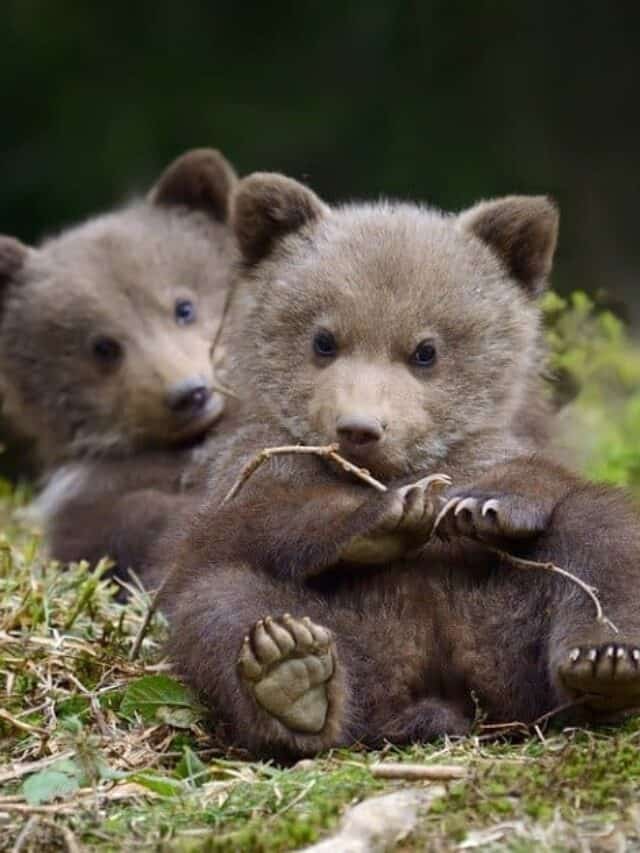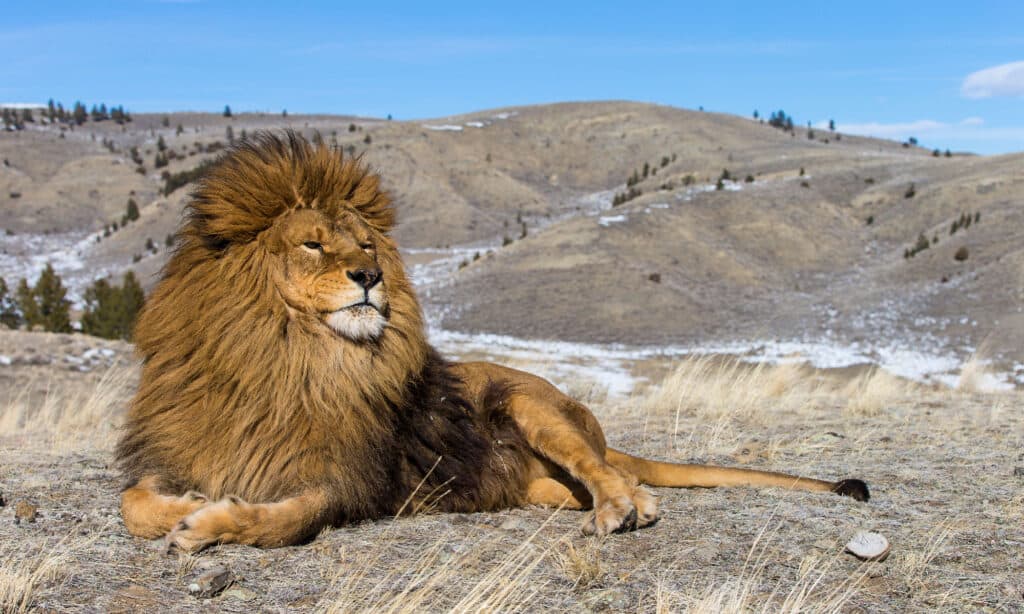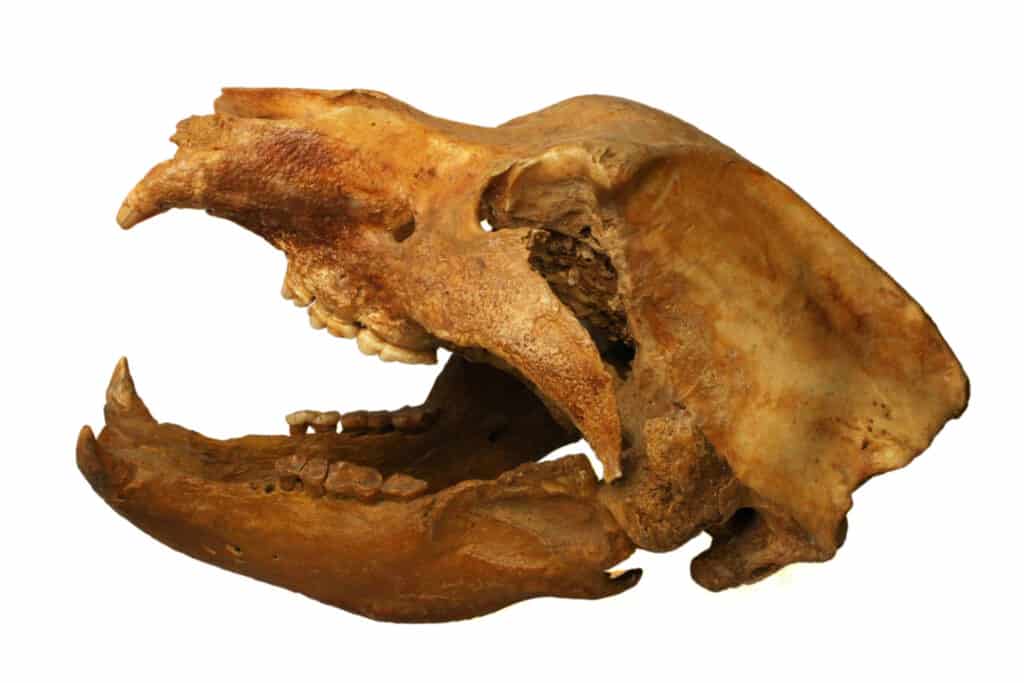
In the wild today, there are eight species of bears.
©iStock.com/Byrdyak
Winnie the Pooh, Paddington Bear, and Smoky the Bear are just a couple popular bears in the media today. In the wild today, there are eight species of bears: American black bears (Ursus americanus), brown bears (Ursus arctos), polar bears (Ursus maritimus), Asian black bears (Ursus tibetanus), panda bears (Ailuropoda melanoleuca), the spectacled bears, also known as the Andean bears (Tremarctos ornatus), sun bears (Helarctos malayanus), and sloth bears (Melursus ursinus). But what about extinct bear species? Are the ones we see today the only ones, or have bear species we have never imagined walked this earth? Let’s find out! This article will explore the 5 coolest extinct bear species!

How Long Have Bears Existed?

Two adult Grizzly bears (
Ursus arctos horribilis)
©Alexandra Giese/Shutterstock.com
Of the carnivore families, bears are the youngest. Bears arose from dog-like ancestors approximately 55-38 million years ago. This may seem like a long time ago, however the first mammals arose 210 million years ago! The earliest undisputed bear species is the dawn bear (Ursuvus elmensis), which lived on Earth from 23 to 5.3 million years ago.
As for modern bear species, speciation events have occurred relatively recently- sun bears diverged from Asiatic and American black bears approximately 6.25-5 million years ago, sloth bears arose about 1.8 million years ago, and polar bears diverged very recently from brown bears between 0.35 and 0.5 million years ago.
Panda bears are incredibly unique amongst living bear species and are called “living fossils” by many scientists. All bears, including pandas, belong to the family Ursidae. Panda bears diverged from a common ancestor of the family Ursidae that would later give rise to the other living bear species. The panda is therefore the oldest living bear species at about 19 million years old!
What Are the Extinct Species of Bears?

Fossil evidence, like the bones of this
cave bear
, help scientists understand extinct species
©Horia Bogdan/Shutterstock.com
Within the family of bears, Ursidae, there are six subfamilies including three subfamilies that are extinct. An additional extinct subfamily is also often recognized as belonging to the bear family, but other scientists believe it is an extinct type of seal. Within these subfamilies there are numerous extinct genera and species. The subfamilies that include the living bear species such as brown bears and black bears also include many extinct species. Within the bear family Ursidae there are approximately 100 extinct species, however, this number changes as new fossil evidence becomes available and is reinterpreted.
Unfortunately, we can’t review all 100 extinct bear species very easily, but here we will check out the 5 coolest extinct bears!
1) Ursavus- The Oldest Bear Genus
![This restoration are mostly based on 820846, a fossil specimen consisting of a crushed skull, vertebral column, tail and limb bones: it was first described in 1985 as a species of the of the "dawn bear" genus Ursavus, named "Ursavus orientalis",[1] but subsequent studies have placed it into Ballusia](https://a-z-animals.com/media/2022/09/Ursavus-Ballusia_restoration-1024x747.jpg)
Rendering of
Ursavus orientalis, similar to
Ursavus elmensis, based on fossil remains.
©Conty, CC BY-SA 4.0 – License
The oldest, undisputable species of bear ever is Ursavus elmensis, also known as the dawn bear. The dawn bear belongs to a close group of extinct bear species called the genus Ursavus. These bears lived for approximately 17.7 million years between 23 million years ago and 5.5 million years ago! Based on fossil evidence, Ursavus bears could have been found in North America, Europe, and Asia during this time. Most species were omnivores, and many were hypocarnivores- animals that have a diet consisting more greatly of fungi, fruits, and/or other plant material than meat. Grizzly bears and black bears are living examples of hypocarnivores because their diet consists of less than 30% meat. To read more about the early evolution of bears, click here!
2) Arctotherium Angustidens- The Largest Bear Ever

An artistic interpretation of
Arctotherium
angustidens
©Daniel Eskridge/Shutterstock.com
Arctotherium angustidens was a massive bear that lived between 2.59-0.01 million years ago! This bear earned its nickname “bear beast” because it is the largest bear to have ever lived. By looking at fossil evidence from Buenos Aires, scientists predict the bear beast’s weight was between 3,500 and 3,900 pounds! This extraordinary size not only makes the bear beast the largest bear that has ever lived, but also makes it one of the largest carnivorous land mammals that has ever lived!
Like all bears, the bear beast falls in the family Ursidae; however, they also share a subfamily with a living bear species. The bear beast, as well 10 other extinct species, is in the subfamily of short-faced bears just like the modern spectacled bear! The spectacled bear is much smaller and is considered a midsized bear with males weighing between 220-440 pounds. The largest bear species alive today is the polar bear with males weighing between 770-1500 pounds. The bear beast was over twice as heavy!
3) The Atlas Bear- The Recently Extinct African Bear Species

The now-extinct Barbary lion coexisted with the Atlas bear in northern
Africa
©Dennis W Donohue/Shutterstock.com
There are no bear species that exist in Africa today. The Atlas bear, however, was alive and inhabiting North Africa until very recently, with extinction occurring around 1870- just over 150 years ago. For some frame of reference, the Atlas bear was still alive during and after the American Civil War! This bear is a close relative to the brown bears we see today; in fact, it is the same species as modern brown bears! Atlas bears are classified separately from extant brown bears on the subspecies level.
Research indicates Atlas bears, Barbary lions, and Barbary leopards were sympatric predator species. This means that they lived in the same geographic range and often encountered each other in the wild. The Barbary lion became extinct in the wild in the 1920s. Some are still alive today in captivity, either in zoos or breeding programs. Barbary leopards, also known as North African leopards, exist in the wild today but are considered a vulnerable species with a decreasing population.
4) Cave Bear- Ursus spelaeus

A Cave Bear skull (
Ursus Spelaeus) from the Carpathian Mountains in Romania
©Tony_Herbert/Shutterstock.com
Cave bears are a bear species from Europe and Asia that became extinct around 24,000 years ago. As their name suggests, these bears spent a substantial amount of time in caves. Their close relative, the modern brown bear, only resides in caves for hibernation. Cave bears had similar skeletal structures as brown bears today and were roughly the size of modern polar bears.
Interestingly, archaeological evidence suggests cave bear skeletons, particularly skulls, were used during prehistoric human rituals. Large graves covered with stone slabs and containing the bones of over 20 cave bears were discovered in France and Switzerland. Additionally, some scientists interpret archaeological findings in an Italian cave as indicative of cave bear worship.
5) Dog Bears- Hemicyoninae

The so-called dog bears, or hemicyonines were actually much closer to bears than to dogs and many experts consider them part of the subfamily Hemicyoninae within the bear family.
©Apokryltaros at English Wikipedia, CC BY-SA 3.0 – License
Another interesting type of extinct bear is the dog bear. Dog bears comprise the now-extinct subfamily of bears called Hemicyoninae which were a group of European bears that greatly resemble large dogs. In fact, their name comes from the Greek word meaning “half dog”. There is some controversy over their classification in the bear family, but they are most widely regarded as a primitive type of bear. These bears were around for approximately 28.6 million years between 33.9 and 5.3 million years ago and several species could also be found in parts of Asia, Africa, and North America! This subfamily included 32 species of dog bear, all of which are now extinct.
The most well-known genus in this subfamily is Hemicyon which includes the most notable species of dog bears. These animals were approximately 5 feet long, 2-3 feet tall, and were up to 350 pounds! Hemicyon species were hypercarnivores which means that 70% or more of their diet was meat. This is very different than some modern bear species, such as brown bears or black bears, that have a hypocarnivorous diet consisting of less than 30% meat. Polar bears, however, are a modern example of hypercarnivorous bear.
Dog bears are not to be confused with the now-extinct species of bear dogs. Bear dogs were a family of dog-like carnivores that lived 42-4.6 million years ago, which means they coexisted with dog bears!
How Are Bears Doing Today?

A female polar bear helps her cubs onto a melting block of ice
©iStock.com/avstraliavasin
Bear species today face a number of challenges in the wild that threaten their livelihood. Polar bears, for example, are having increasing difficulty acquiring food, traversing large areas in the Arctic, and raising their young due to climate change. Brown bear populations are declining and many subspecies, such as the Atlas bear, have recently become extinct; for example, the California brown bear that is on the California state flag became extinct in 1924. Panda bears have had a long history on the endangered species list but have most recently been reclassified as “vulnerable” with populations increasing. Although there are many very interesting extinct species of bears, it is very important that a conscious effort is made to protect the bear species still living on Earth today.
Summary of 5 Extinct Types of Bears
| 1 | Extinct Bear | When They Lived |
|---|---|---|
| 1 | Ursavus elmensis (dawn bear) | 23 to 5.5 million years ago |
| 2 | Arctotherium Angustidens (bear beast) | 2.59 to 0.01 million years ago |
| 3 | Ursus arctos crowtheri (atlas bear) | 150 years ago |
| 4 | Ursus spelaeus (cave bear) | 24,000 years ago |
| 5 | Hemicyoninae (dog bears) | 33.9 to 5.3 million years ago |
The photo featured at the top of this post is © iStock.com/Jess Bray
Thank you for reading! Have some feedback for us? Contact the AZ Animals editorial team.






